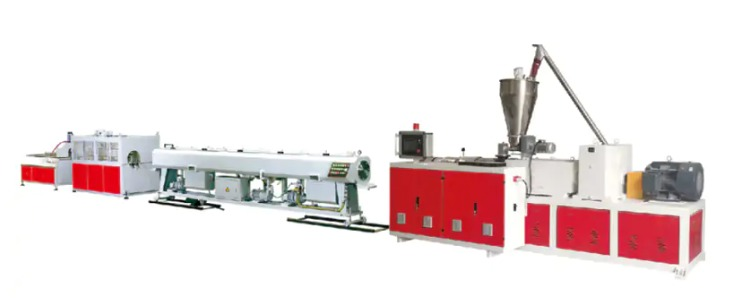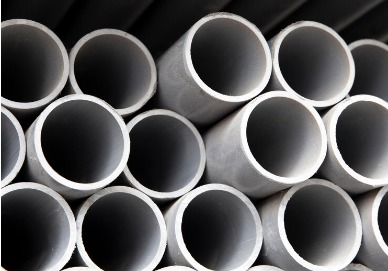PVC pipe-making plants must operate for product quality, productivity, and cost. Meanwhile, the plastic pipe-making machine is essential. These systems ensure pipe diameters are uniform and meet industry requirements. Radical machinery may boost output while improving industrial productivity. So, the plant’s performance and viability depend on the selection and upkeep of this equipment. This article delves into the crucial aspects of effective operation, addressing common issues and providing valuable tips for enhancing performance.
Common Issues in Operating PVC Pipe Manufacturing Machine
1. Material Feed Issues
Consistent material feed is vital for uniform product quality in plastic pipe-making machines. Issues may arise from uneven material flow due to hopper design flaws or irregular particle sizes of the raw plastic. For instance, bridging in the hopper can cause feed rate inconsistencies to impact the dimensional stability of the pipes. Moreover, a poorly calibrated gravimetric or volumetric feeder can cause fluctuations in the material feed rate to affect the extrusion process.
2. Temperature Fluctuations
In plastic pipe-making machines, Temperature control influences the melt flow and final product quality. Fluctuations can occur due to poor heating system design or temperature sensors. For example, uneven heating in the barrel can cause temperature gradients for melt consistency issues.
3. Extrusion Die Blockages
Extrusion die-blockages are a challenge in plastic pipe manufacturing machines. They might be caused by impurities in the plastic material or degraded material in the die while disrupting the uniform flow of the plastic melt. Steady cleaning and maintenance of the die are key. In addition, a die design that diminishes dead zones decreases blockage occurrences. It is where material can degrade and accumulate.
4. Cooling System Inefficiencies
In plastic pipe-making machines, the cooling system defines the final properties of the pipe. Inefficiencies, including uneven cooling or inadequate cooling system capacity, can cause warping or residual stresses in the pipes. For instance, a poorly designed water bath can result in irregular cooling rates along the pipe circumference.
(Copyright photo from https://www.freepik.com/free-photo/minimalist-construction-pvc-pipes-assortment_18774359.htm#query=pvc%20pipe&position=0&from_view=search&track=ais&uuid=5f2cb177-6ef2-4634-9a79-1eef966dc4a3)
Tips for Effective Operation of PVC Pipe-Making Machine
1. Selecting the Right PVC Pipe Machine
When choosing a plastic pipe-making machine, highlight machines with an extruder that can handle high melt flow rates for steady pipe thickness. Opt for machines with cutting-edge screw designs for better PVC compounding efficiency. Machines featuring precise temperature control systems uphold material properties throughout extrusion. Besides, consider a machine with modular die-heads for flexibility in pipe sizes and wall thicknesses for production requirements.
Please also read Choosing the Perfect PVC Pipe Production Line: A Comprehensive Guide.
PVC Extruders Unveiled: Exploring Types and Components.
Choosing Between Single Screw and Twin Screw Extruders.
2. Pre-Operation Checks
Before operating a plastic pipe-making machine, conduct inspections of critical components, including the screw and barrel, for signs of wear or damage. Confirm that the calibration unit is aligned to preclude pipe wall thickness variations. Also, verify the accuracy of temperature control systems, the functionality of vacuum and cooling systems, and the anticipated pipe dimensions and properties. Undoubtedly, this methodology curtails the peril of defects and idle time.
3. Proper Maintenance
Proper maintenance of a plastic pipe-making machine is central to its durability and function. Implement an upkeep schedule that includes intermittent cleaning of the extruder screw and barrel to stop material buildup. Lubricate moving parts to lessen friction and wear. Replace worn-out dies and calibrators for pipe quality. Keeping electrical parts clean and dust-free gives ideal operation and safety. Such maintenance avoids sudden breakdowns and keeps production uniform.
4. Optimizing Production Efficiency
Optimize the extrusion speed according to material properties and pipe dimensions for better efficiency in a plastic pipe-making machine. Employ real-time monitoring systems to track production melt temperature and pressure while adjusting them for the finest output. Utilize automated dimensional control systems for reliable pipe sizing, which decreases waste and increases yield. Material handling systems can also rationalize the feeding process for efficiency.
5. Training and Development
Complete training for operators of plastic pipe-making machines is needed. Ensure they realize the machine’s workings from the extrusion process to the calibration unit. Training may cover troubleshooting common issues, inferring data from monitoring systems, and applying best practices for upkeep. Frequently updating their skills with the latest tech progressions and industry trends provides a high level of competency, which impacts machine working and product quality.
Conclusion
Plastic pipe-making requires a reliable supplier for quality and efficiency. Look no further than Haohua for your solution, as we bring years of production and technical expertise. Haohua goes beyond machine provision; we assist with meticulous factory planning and provide staff training to ensure a smooth integration into your production workflow.
As a seasoned PVC pipe supplier, Haohua holds prestigious certifications from renowned organizations worldwide, including ISO and CE. With over 30 years of dedicated experience in PVC pipe machine development and manufacturing, we stand as a beacon of reliability and innovation in the industry. Choose Haohua for excellence in plastic pipe production, where expertise meets efficiency.




